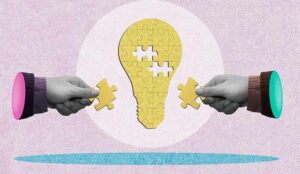Customer service interactions have shifted from human interactions to self-service.
Gal Rimon at Centrical explores how the introduction of generative AI innovations raises the question: what kind of human interactions should customers expect from customer support and sales staff?
How does Jennifer Coolidge want to be treated by a service agent? This is the question in the latest Discover ad.
Discover Financial Services recently launched a campaign called “Especially for Everyone,” which features a hilarious commercial where Jennifer Coolidge, who plays her clueless White Lotus character, Tanya, thinks that she’s chatting with a robot and not a person.
This commercial sparks an intriguing conversation about the future of CX (Customer Experience). In the past decade, more and more interactions with customer service providers have shifted from human interactions to self-service.
In the past two years, because of OpenAI’s ChatGPT, LLMs, and other generative AI innovations, this trend has increased significantly.
A major question is, what kind of human interactions would be expected between customers and human agents, such as customer support and sales staff.
To Begin With, Let’s Explore the Characteristics of These Sales and Service Interactions:
1. Escalated
Many of these interactions will come after a previous attempt to fix a problem on the website, application or other self-service channel failed. Therefore, this means that the customer will likely be impatient, frustrated and even angry.
2. Complicated
When the issue gets raised to a higher level, it is likely that the problem is unique or complex, and involves connections with multiple systems, or even across different companies (e.g., hotel chain, credit card company, and reservations websites).
3. Expert Guidance
Oftentimes, these interactions are coming from customers seeking expert advice. Case in point. Recently I decided to prepare sushi for the first time. Instead of ordering the products online, I preferred to chat with the fish store staff and the Japanese store specialist.
They recommended the appropriate products, advised me on the quantities, and offered me great tips. My experience was more than just – purchasing the products, but a learning opportunity from experts, whom I could trust.
Now, Let’s Understand What Is Required From the Human Agent to Effectively Provide Support in These Situations:
1. Empathy
Because the conversation will often begin with a high level of frustration, the agent will need to show a lot of empathy to de-escalate the caller and lower the level of frustration.
Then they will provide a constructive solution to the problem, in which a positive conversation will prevail. People appreciate being heard, and in rare cases where there is no solution, they can feel better just from having their frustration acknowledged.
2. Trusted Advisor
I believe that the best sales and customer service agents are not just focused on answering the questions. They should help the customer to ask the right questions.
To be a trusted advisor, the agent needs to be an expert in their domain, to care about the customer, to understand their challenges, and to help them define their needs.
For example, if you want to buy a backpack – the seller will help you consider all your needs: for short trips or long ones, for hiking or daily use, etc. Based on your specific needs, they will recommend options that are the relevant sizes, materials, and internal design.
3. Creativity
A good sales and service person will demonstrate creativity in difficult situations. For instance, my travel agent is very creative in finding solutions for my complex travel patterns.
I travel a lot for work and my trips are not simple. I have to handle many constraints, such as multiple states (and continents) in one week, flight times to match meeting times, unexpected changes, budget, and more. She can choose the best options among different airlines, airports, layover risks, and more.
Last week, I was in Ohio, and my next meeting in Florida was cancelled at the last minute. The United app and website could not provide a good alternative flight.
I called the United agent and he was amazing. He helped me to find another option with a two-hour drive from where I was (I got an extra customer meeting there). He was empathetic, consultative, and creative.
The outcome: A bad situation turned into a memorable and differentiated experience. Later that week, in a marketing meeting about messaging, I brought up this event. It was the best advertisement for United!
We say that the Employee Experience has to be central, along with the CX. Companies must treat their people as talent and invest more in their future readiness. They have to aim for a high standard as an empathetic, creative trusted advisor that will deliver an amazing CX and to surprise their customer with memorable moments.
For that to happen, a second revolution is needed. The first one was focused on the customer experience (CX): customer centricity, omnichannel, focus on the experience and the personalization of the customer, and so on.
The Second Revolution Should Be Around the Risk of Employee Experience (EX)
Or even more specifically, the Employee Performance Experience. Employee experience needs to be personalized, guided, engaging, and focused toward positive outcomes for their customers and their personal development.
A Performance Experience Platform (PXP) utilizes AI to integrate different services around the employee for an engaging and personalized experience, combining Real-time Performance Management and Feedback, Adaptive Microlearning, Coaching and Quality Evaluations, the voice of the Employee, Rewards, Recognition, and Gamification. This will meet the employees’ expectations of being treated like their customers.
The advantages are significant: improved CX, increased productivity and efficiency, consistent performance throughout the organization, lower employee turnover and early attrition, quicker onboarding times, and higher employee engagement.
This blog post has been re-published by kind permission of Centrical – View the Original Article
For more information about Centrical - visit the Centrical Website
Call Centre Helper is not responsible for the content of these guest blog posts. The opinions expressed in this article are those of the author, and do not necessarily reflect those of Call Centre Helper.
Author: Centrical
Published On: 30th May 2024 - Last modified: 23rd Oct 2024
Read more about - Guest Blogs, Centrical






 Centrical provides a real-time performance management, microlearning, gamification, coaching, and voice of the employee platform for frontline teams. The solution inspires and personally guides employee success and growth by making every moment actionable.
Centrical provides a real-time performance management, microlearning, gamification, coaching, and voice of the employee platform for frontline teams. The solution inspires and personally guides employee success and growth by making every moment actionable. 








